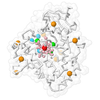[English] 日本語
 Yorodumi
Yorodumi- PDB-9cvk: Structure of rat neuronal nitric oxide synthase R349A mutant heme... -
+ Open data
Open data
- Basic information
Basic information
| Entry | Database: PDB / ID: 9cvk | ||||||
|---|---|---|---|---|---|---|---|
| Title | Structure of rat neuronal nitric oxide synthase R349A mutant heme domain bound with 6-(3-chloro-5-((methylamino)methyl)phenyl)-4-methylpyridin-2-amine dihydrochloride | ||||||
 Components Components | Nitric oxide synthase, brain | ||||||
 Keywords Keywords | OXIDOREDUCTASE / nitric oxide synthase inhibitor binding | ||||||
| Function / homology |  Function and homology information Function and homology informationnegative regulation of hepatic stellate cell contraction / Nitric oxide stimulates guanylate cyclase / positive regulation of adenylate cyclase-activating adrenergic receptor signaling pathway / negative regulation of iron ion transmembrane transport / response to vitamin B3 / postsynaptic specialization, intracellular component / ROS and RNS production in phagocytes / azurophil granule / synaptic signaling by nitric oxide / Ion homeostasis ...negative regulation of hepatic stellate cell contraction / Nitric oxide stimulates guanylate cyclase / positive regulation of adenylate cyclase-activating adrenergic receptor signaling pathway / negative regulation of iron ion transmembrane transport / response to vitamin B3 / postsynaptic specialization, intracellular component / ROS and RNS production in phagocytes / azurophil granule / synaptic signaling by nitric oxide / Ion homeostasis / negative regulation of vasoconstriction / response to nitric oxide / positive regulation of adenylate cyclase-activating G protein-coupled receptor signaling pathway / negative regulation of cytosolic calcium ion concentration / response to vitamin E / positive regulation of sodium ion transmembrane transport / peptidyl-cysteine S-nitrosylase activity / cadmium ion binding / positive regulation of the force of heart contraction / negative regulation of calcium ion transport / negative regulation of potassium ion transport / regulation of postsynaptic membrane potential / nitric oxide mediated signal transduction / nitric-oxide synthase (NADPH) / sodium channel regulator activity / regulation of neurogenesis / negative regulation of serotonin uptake / nitric-oxide synthase activity / multicellular organismal response to stress / xenobiotic catabolic process / L-arginine catabolic process / postsynaptic density, intracellular component / NADPH binding / striated muscle contraction / nitric oxide-cGMP-mediated signaling / regulation of sodium ion transport / negative regulation of blood pressure / response to hormone / behavioral response to cocaine / nitric oxide metabolic process / nitric oxide biosynthetic process / photoreceptor inner segment / T-tubule / cellular response to epinephrine stimulus / sarcoplasmic reticulum membrane / secretory granule / calyx of Held / sarcoplasmic reticulum / positive regulation of long-term synaptic potentiation / response to activity / cell periphery / response to nicotine / response to nutrient levels / phosphoprotein binding / establishment of protein localization / establishment of localization in cell / cellular response to mechanical stimulus / female pregnancy / negative regulation of insulin secretion / response to peptide hormone / sarcolemma / caveola / cellular response to growth factor stimulus / potassium ion transport / response to lead ion / response to estrogen / vasodilation / Z disc / calcium-dependent protein binding / calcium ion transport / FMN binding / NADP binding / flavin adenine dinucleotide binding / positive regulation of neuron apoptotic process / response to heat / ATPase binding / scaffold protein binding / response to ethanol / nuclear membrane / response to lipopolysaccharide / dendritic spine / negative regulation of neuron apoptotic process / RNA polymerase II-specific DNA-binding transcription factor binding / transmembrane transporter binding / mitochondrial outer membrane / cytoskeleton / calmodulin binding / response to hypoxia / postsynaptic density / membrane raft / negative regulation of cell population proliferation / heme binding / synapse / dendrite / negative regulation of apoptotic process / positive regulation of DNA-templated transcription / perinuclear region of cytoplasm / glutamatergic synapse / enzyme binding / positive regulation of transcription by RNA polymerase II Similarity search - Function | ||||||
| Biological species |  | ||||||
| Method |  X-RAY DIFFRACTION / X-RAY DIFFRACTION /  SYNCHROTRON / SYNCHROTRON /  FOURIER SYNTHESIS / Resolution: 1.901 Å FOURIER SYNTHESIS / Resolution: 1.901 Å | ||||||
 Authors Authors | Li, H. / Poulos, T.L. | ||||||
| Funding support |  United States, 1items United States, 1items
| ||||||
 Citation Citation |  Journal: Bioorg.Med.Chem. / Year: 2025 Journal: Bioorg.Med.Chem. / Year: 2025Title: Truncated pyridinylbenzylamines: Potent, selective, and highly membrane permeable inhibitors of human neuronal nitric oxide synthase. Authors: Vasu, D. / Do, H.T. / Li, H. / Hardy, C.D. / Poulos, T.L. / Silverman, R.B. | ||||||
| History |
|
- Structure visualization
Structure visualization
| Structure viewer | Molecule:  Molmil Molmil Jmol/JSmol Jmol/JSmol |
|---|
- Downloads & links
Downloads & links
- Download
Download
| PDBx/mmCIF format |  9cvk.cif.gz 9cvk.cif.gz | 192.5 KB | Display |  PDBx/mmCIF format PDBx/mmCIF format |
|---|---|---|---|---|
| PDB format |  pdb9cvk.ent.gz pdb9cvk.ent.gz | Display |  PDB format PDB format | |
| PDBx/mmJSON format |  9cvk.json.gz 9cvk.json.gz | Tree view |  PDBx/mmJSON format PDBx/mmJSON format | |
| Others |  Other downloads Other downloads |
-Validation report
| Summary document |  9cvk_validation.pdf.gz 9cvk_validation.pdf.gz | 1.1 MB | Display |  wwPDB validaton report wwPDB validaton report |
|---|---|---|---|---|
| Full document |  9cvk_full_validation.pdf.gz 9cvk_full_validation.pdf.gz | 1.1 MB | Display | |
| Data in XML |  9cvk_validation.xml.gz 9cvk_validation.xml.gz | 20.9 KB | Display | |
| Data in CIF |  9cvk_validation.cif.gz 9cvk_validation.cif.gz | 26.8 KB | Display | |
| Arichive directory |  https://data.pdbj.org/pub/pdb/validation_reports/cv/9cvk https://data.pdbj.org/pub/pdb/validation_reports/cv/9cvk ftp://data.pdbj.org/pub/pdb/validation_reports/cv/9cvk ftp://data.pdbj.org/pub/pdb/validation_reports/cv/9cvk | HTTPS FTP |
-Related structure data
| Related structure data |  9cviC  9cvjC  9cvlC  9cvmC  9cvnC  9cvoC  9cvpC  9cvqC  9cvrC  9cvsC 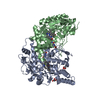 9cvuC  9cvvC  9cvwC  9cvxC  9cvyC  9cvzC  9cw0C  9cw1C  9cw2C 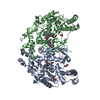 9cw3C  9cw4C  9cw5C  9cw6C  9cw7C  9cw8C  9cw9C 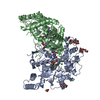 9cwdC  9cwiC  9cwjC  9cwkC C: citing same article ( |
|---|---|
| Similar structure data | Similarity search - Function & homology  F&H Search F&H Search |
- Links
Links
- Assembly
Assembly
| Deposited unit | 
| ||||||||
|---|---|---|---|---|---|---|---|---|---|
| 1 |
| ||||||||
| Unit cell |
| ||||||||
| Components on special symmetry positions |
|
- Components
Components
-Protein , 1 types, 1 molecules A
| #1: Protein | Mass: 48726.410 Da / Num. of mol.: 1 / Mutation: R349A Source method: isolated from a genetically manipulated source Source: (gene. exp.)   |
|---|
-Non-polymers , 6 types, 47 molecules 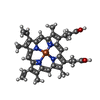
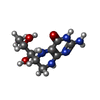







| #2: Chemical | ChemComp-HEM / |
|---|---|
| #3: Chemical | ChemComp-H4B / |
| #4: Chemical | ChemComp-A1A0G / ( Mass: 261.750 Da / Num. of mol.: 1 / Source method: obtained synthetically / Formula: C14H16ClN3 / Feature type: SUBJECT OF INVESTIGATION |
| #5: Chemical | ChemComp-ACT / |
| #6: Chemical | ChemComp-ZN / |
| #7: Water | ChemComp-HOH / |
-Details
| Has ligand of interest | Y |
|---|---|
| Has protein modification | N |
-Experimental details
-Experiment
| Experiment | Method:  X-RAY DIFFRACTION / Number of used crystals: 1 X-RAY DIFFRACTION / Number of used crystals: 1 |
|---|
- Sample preparation
Sample preparation
| Crystal | Density Matthews: 2.48 Å3/Da / Density % sol: 50.4 % / Description: bricks |
|---|---|
| Crystal grow | Temperature: 278 K / Method: vapor diffusion, sitting drop / pH: 5.8 Details: 20-24% PEG3350, 0.1M MES 0.14-0.20M AMMONIUM ACETATE, 10% ETHYLENE GLYCOL, 30uM SDS, 5 mM GSH |
-Data collection
| Diffraction | Mean temperature: 100 K / Serial crystal experiment: N |
|---|---|
| Diffraction source | Source:  SYNCHROTRON / Site: SYNCHROTRON / Site:  ALS ALS  / Beamline: 8.2.1 / Wavelength: 1 Å / Beamline: 8.2.1 / Wavelength: 1 Å |
| Detector | Type: ADSC QUANTUM 315 / Detector: CCD / Date: Sep 15, 2022 / Details: mirrors |
| Radiation | Monochromator: DOUBLE CRYSTAL SI(III) / Protocol: SINGLE WAVELENGTH / Monochromatic (M) / Laue (L): M / Scattering type: x-ray |
| Radiation wavelength | Wavelength: 1 Å / Relative weight: 1 |
| Reflection | Resolution: 1.9→46.53 Å / Num. obs: 35691 / % possible obs: 99 % / Redundancy: 8.1 % / CC1/2: 0.998 / Rmerge(I) obs: 0.1 / Rpim(I) all: 0.034 / Rrim(I) all: 0.106 / Net I/σ(I): 8.3 / Num. measured all: 289665 |
| Reflection shell | Resolution: 1.9→1.94 Å / % possible obs: 98 % / Redundancy: 6.1 % / Rmerge(I) obs: 6.546 / Num. measured all: 13799 / Num. unique obs: 2254 / CC1/2: 0.322 / Rpim(I) all: 2.832 / Rrim(I) all: 7.146 / Net I/σ(I) obs: 0.4 |
- Processing
Processing
| Software |
| ||||||||||||||||||||||||||||||||||||||||||||||||||||||||||||||||||||||||||||||||||||||||||||||||||||||||||||||||||||||||||||||||||||||||||||||||||||||||||||||||||||||||
|---|---|---|---|---|---|---|---|---|---|---|---|---|---|---|---|---|---|---|---|---|---|---|---|---|---|---|---|---|---|---|---|---|---|---|---|---|---|---|---|---|---|---|---|---|---|---|---|---|---|---|---|---|---|---|---|---|---|---|---|---|---|---|---|---|---|---|---|---|---|---|---|---|---|---|---|---|---|---|---|---|---|---|---|---|---|---|---|---|---|---|---|---|---|---|---|---|---|---|---|---|---|---|---|---|---|---|---|---|---|---|---|---|---|---|---|---|---|---|---|---|---|---|---|---|---|---|---|---|---|---|---|---|---|---|---|---|---|---|---|---|---|---|---|---|---|---|---|---|---|---|---|---|---|---|---|---|---|---|---|---|---|---|---|---|---|---|---|---|---|
| Refinement | Method to determine structure:  FOURIER SYNTHESIS / Resolution: 1.901→46.53 Å / SU ML: 0.27 / Cross valid method: FREE R-VALUE / σ(F): 0.06 / Phase error: 44.62 / Stereochemistry target values: ML FOURIER SYNTHESIS / Resolution: 1.901→46.53 Å / SU ML: 0.27 / Cross valid method: FREE R-VALUE / σ(F): 0.06 / Phase error: 44.62 / Stereochemistry target values: ML
| ||||||||||||||||||||||||||||||||||||||||||||||||||||||||||||||||||||||||||||||||||||||||||||||||||||||||||||||||||||||||||||||||||||||||||||||||||||||||||||||||||||||||
| Solvent computation | Shrinkage radii: 0.9 Å / VDW probe radii: 1.11 Å / Solvent model: FLAT BULK SOLVENT MODEL | ||||||||||||||||||||||||||||||||||||||||||||||||||||||||||||||||||||||||||||||||||||||||||||||||||||||||||||||||||||||||||||||||||||||||||||||||||||||||||||||||||||||||
| Refinement step | Cycle: LAST / Resolution: 1.901→46.53 Å
| ||||||||||||||||||||||||||||||||||||||||||||||||||||||||||||||||||||||||||||||||||||||||||||||||||||||||||||||||||||||||||||||||||||||||||||||||||||||||||||||||||||||||
| Refine LS restraints |
| ||||||||||||||||||||||||||||||||||||||||||||||||||||||||||||||||||||||||||||||||||||||||||||||||||||||||||||||||||||||||||||||||||||||||||||||||||||||||||||||||||||||||
| LS refinement shell |
| ||||||||||||||||||||||||||||||||||||||||||||||||||||||||||||||||||||||||||||||||||||||||||||||||||||||||||||||||||||||||||||||||||||||||||||||||||||||||||||||||||||||||
| Refinement TLS params. | Method: refined / Origin x: -23.6246 Å / Origin y: -4.9769 Å / Origin z: 22.2643 Å
| ||||||||||||||||||||||||||||||||||||||||||||||||||||||||||||||||||||||||||||||||||||||||||||||||||||||||||||||||||||||||||||||||||||||||||||||||||||||||||||||||||||||||
| Refinement TLS group | Selection details: (chain A and resid 299:716) |
 Movie
Movie Controller
Controller


 PDBj
PDBj
